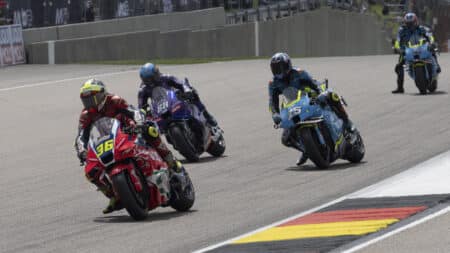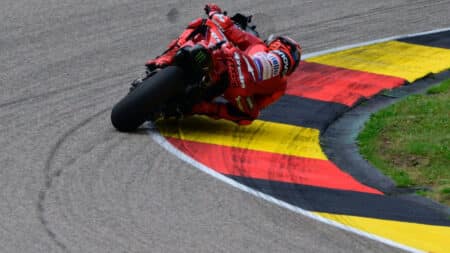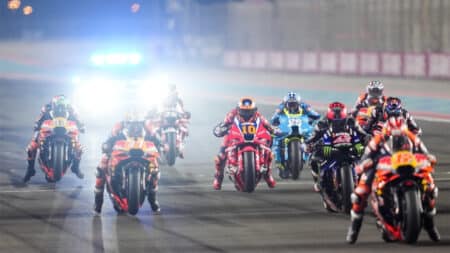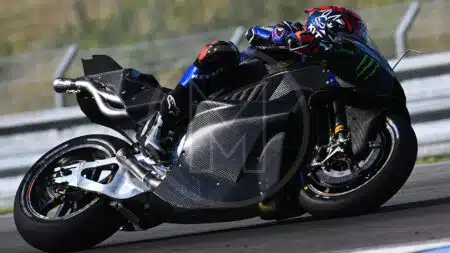Many of you probably already know something about bike racing’s greatest story of industrial espionage, when East German Ernst Degner defected through the Iron Curtain at the height of the Cold War, carrying with him MZ’s hard-won two-stroke secrets. Degner sold MZ’s knowhow to the struggling Suzuki factory, which went on to win its first GP victories and first World Championship the very next year.

For all we know, stuff like this happens all the time; we just don’t get to hear about it. But we did get to hear about something that happened 10 years ago in Ireland.
It occurred in May 2005 on the eve of the BSB round at Mondello Park in County Kildare. While riders slept in their motorhomes and caravans, a thief crept through the paddock with a set of bolt-cutters, sneaked round the back of the Michelin truck, broke in, located the specific rear slick he was after and escaped unnoticed into the night.

Understandably, Michelin bosses were apoplectic. The French company was the dominant force in motorcycle racing at the time, with an unbroken run of 13 500/MotoGP titles, so its technology was the envy of the world. It had also dominated in World Superbikes until WSB switched to a single tyre supplier in 2004, with Pirelli. Michelin was heavily involved with HRC and needed somewhere to develop tyres for the hugely prestigious Suzuka Eight Hours race, run to Superbike spec. Hence its involvement in BSB.
There was never any doubt that the Mondello robbery was anything but a professional job and therefore an act of industrial espionage by a rival tyre company. But which one? No-one was ever caught and to this day no-one except the perpetrators knows what followed. Presumably the tyre was dissected and had its compound and construction intimately examined. Someone would have learned things they otherwise might never have learned, just like the Suzuki/MZ skulduggery.
Both these stories have always fascinated me. It’s the murky underbelly of racing, where companies resort to seriously dodgy tactics in their desperation to win on the track.
There are plenty of other tales of spying for speed in bike racing, though my favourite concerns Honda and Suzuki during the French GP at Le Mans in July 1989. This time, Suzuki was having secrets stolen from them, allegedly. What goes around, comes around.

Photo: Wikimedia
This is 1987 500 World Champion and factory Honda rider Wayne Gardner’s version of the story, which has (of course) been denied by HRC. “It was real hot and Suzuki had their awning rolled up, just over the way from where my motorhome was parked. I told the Japanese, ‘Hey, you should take some photos’. So one of them came in with a big lens and spent all day there behind the mirror windows taking rolls and rolls of film. Then they went back to Japan, blew up the shots and laid them over shots of an NSR. After that the penny dropped, they realised they had too much weight low down. The Suzuki engine was much higher in the frame, so they realised maybe they should go that way. All of a sudden Honda worked out how to make a bike handle and it took off from there. To cut a long story short, they didn’t have a f***ing clue until then.”
That, according to Gardner, is how HRC learned to build a 500 GP chassis, though the input it got from Eddie Lawson and Erv Kanemoto in 1989 and also from Mick Doohan surely played the major part.
Anyway, I digress: back to tyres. Bridgestone is now the dominant force in motorcycle racing and now it’s Michelin’s turn to play catch-up as it works towards supplying MotoGP’s control tyres from 2016.
It certainly has some work to do, but that’s only to be expected after seven years out of MotoGP, following the championship’s wholesale switch to Bridgestone in 2009. At Sepang last week, front-end grip was the concern.

Jorge Lorenzo and Andrea Dovizioso were among several riders who lost the front and crashed at Turns Three and Five. Both these corners are fast and downhill, exactly the kind of situation in which it can be difficult to get the front tyre fully loaded. The corners are long and sweeping, with high entry speed, so the rider cannot nail the brakes and squish the front tyre to expand the contact patch for extra grip. Also, the track drops away, so it’s negative camber, which only exacerbates this problem.
Back in the final days of the Michelin/Bridgestone/Dunlop tyre war, Michelin’s handicap against Bridgestone was always the front tyre. Casey Stoner was particularly critical when he used Michelins in 2006 and found himself in heaven when he switched to Bridgestones in 2007.
But in racing, nothing is for free. MotoGP technology is so rarefied that you very, very rarely gain in one area of performance without losing in another. Back in the days when Michelin dominated 500 GPs, it would brew up a new compound with better grip, but usually with less feel. The grey area between full traction and zero traction had been narrowed in the search for ultimate speed, so the tyre gave more grip but with more risk. Riders like Mick Doohan could survive on that knife edge but many others couldn’t. Instead they’d find themselves flying through the air, on their way to a whole new world of pain. But then Michelin would come out with a better tyre, which retained the same level of ultimate grip but with more forgiveness. That’s how development works.
Bridgestone’s success has been built on grip, rather than feel. It’s rightly taken advantage of hi-tech traction control technology that senses impending disaster before most human brains can. And somehow its front slick simply offers vast amounts of corner-entry grip, so that riders can hurl themselves into turns with the front brake on.

Colin Edwards is a Michelin-contracted rider (and a twice WSB title winner with the French firm), so he’s not a disinterested party in all this, but I believe that what he told me last October is about as close to the mark as you’ll get.
“Do I think Bridgestones are the absolutely the best tyre on the planet? Well, the lap times say so,” he said. “Did I have more feel with the other tyres? Absolutely! Once we went to Bridgestone, it went from feel to faith. You had to have faith in the tyres. You go in a little harder the next lap because it worked the last lap, then you bite off a little more the next lap. My best ‘feel’ moments were 2004, 2005 and 2006 when Michelin built stuff that you could take to limit and then push even more because you had so much feel.”
So, will Michelin have to build a front tyre that relies on faith rather than feel for the 2016 MotoGP season? Because that’s what the riders are used to and riders don’t usually like change when it comes to front tyres.
And what if Michelin’s front tyre stays as it is now? The paddock theory goes that it will perfectly suit Lorenzo’s buttery-smooth corner-entry style (in spite of his Sepang crash) and that Valentino Rossi will also get along with it fine. The man who may have to change his ways is the master of the chuck-it-in-and-hope-for-the-best corner-entry style, Marc Márquez. But that’s only a paddock theory and we know all about them.
One final thought: I wonder if Bridgestone will be double-locking its MotoGP trucks from now on?










